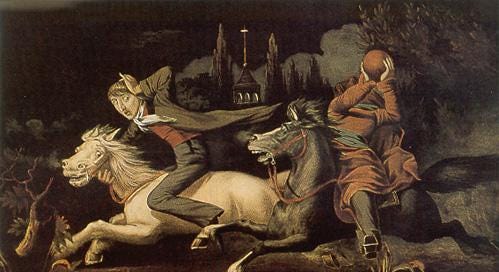Donald Trump does not lie. The tweets, pronouncements and executive orders emanating from the White House are “Tall Tales,” misrepresentations of reality boosted on high stilts, fantasies floating magnificently beyond the believable.
His first Tall Tale—I shall build a wall, and the Mexican government will pay for it--won him the Republican nomination. In his 2024 campaign and the early days of his new Administration, his beyond-belief whoppers include promises to stop unfair international trade, annex Greenland and Panama, deport all who entered illegally, halt the Russian-Ukrainian war, resolve the Israeli-Hamas conflict, prevent Iranian nuclear armament, eliminate Diversity, Equity, and Inclusion (DEI), and end taxes on tips, over-time, state taxes and social security benefits.
Image: commons.wikimedia.org - Artist William J. Wilgus
The Tall Tale is America’s quintessential literary form. Every high school graduate knows—or should know—about Ichabod Crane’s flight from the headless horseman, Hester’s proudly displayed scarlet letter, Pequot’s destruction by a willful white whale, and a cask of sherry hidden away at the remote rear of an underground cellar. The greatest Tall Tale takes readers on a raft southward down the perilous Mississippi.
Tall Tales are to be judged not by their veracity, or even by their plausibility, but by their illumination of larger realities, whether they be social oppression (Hawthorne), struggle against fate (Melville), capacity for evil (Poe), or race-transcending humanity (Twain).
The political Tall Tale is not an invention of the Trump Administration. Woodrow Wilson’s incapacities were disguised by aides for more than a year as his administration concluded disappointedly. Amazingly, Franklin Delano Roosevelt announced a need for six new Supreme Court justices to help sitting septuagenarians. Richard Nixon said he knew nothing about a break-in at the Watergate. Bill Clinton denied sex with a White House intern. The New York Times says the arrival of a slave in 1619 exceeds in importance the struggle for liberty in 1776. Elite universities claim they diversify without discriminating against white males. No one is lying; they only purvey Tall Tales.
For Trump, the purpose of the tales is, of course, to “Make America Great Again.” The wall stands for unlimited immigration; tariffs for other nation’s exploitations of American generosity; Harvard for DEI capture of elite institutions; Ukraine for European irresponsibility; tax and expenditure cuts for economic growth.
To succeed, an absurd tale must be told without a smile—all the way to a conclusive end. The listener must be given no hint the account is anything other than the marvelous—or bitter—truth. The more extraordinary the account, the straighter the face. Ichabod Crane disappears. All but Ishmael (so the story may be told) disappear into the open seas. The cellar wall is bricked in. Jim is finally granted freedom.
In politics, the absurd must remain the truth until the issue is resolved. The false 1619 history of American is marketed to school children as an historical truth. A tax and spending law is cheered even when it has strayed from the lawmakers’ original objectives. Tariff policies are effective no matter how many the number of adjustments that are made. A U.S. presence in Greenland and Panama is established even without an official transfer of sovereignty.
But rhetoric cannot resolve every Tall Tale. What if Putin chooses not to end the war and the Europeans lack the capacity to stop his advances? What if the Israeli-Hamas war never ends?
For the undeniable, Trump bets that, in politics, trying, not winning, counts the most. Defeats can be attributed to heinous enemies or perfidious friends. If the narrative is unresolved when time runs out, the baton can be passed to a successor.
In the land of the Tall Tale, two verities remain. First, once unleashed at scale, false narratives are difficult to contain. Practitioners will be multiple, and the practice will last longer than four more years. The best to hope for is the freedom to tell fabrications. Second, look at what happens when the feet have arrived. Feet may travel circuitous routes but they do not lie.
__________________________________________________________________
Paul E. Peterson is a senior fellow at the Hoover Institution, Stanford University and a professor of government at Harvard University.




